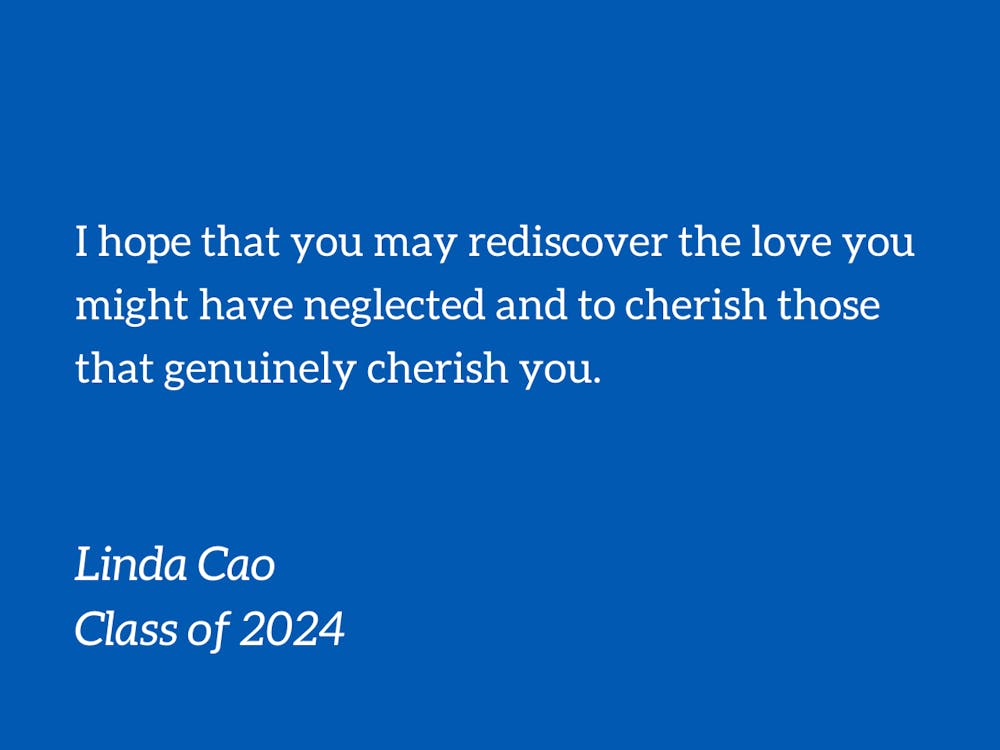I found love under a cherry blossom tree.
On my way back to Craven from Edens, my friend and I were trailing behind a boy and a girl. Perhaps it was because the moonlight was gazing at them with a knowing adoration and the scenery mimicked the intimate nightlife seen on a poster for La La Land, but I knew, from the way her shoulder ‘accidently’ bumped into him and his miserable attempt to fight off a smile, that they were in love.
“Look at that,” I whispered to my friend. “Isn’t that adorable?”
“What is?”
“He’s walking her home,” I explained.
“Oh.”
“I want that someday.”
At the fork between Wannamaker, Keohane, and Craven, there are blooming cherry blossom trees. (Honestly, they probably aren’t cherry blossom trees, but, to me, the resemblance is uncanny.) On the railings that overlook the Keohane bridge, there, the girl who was loved stood, with her arms outstretched, breathing in the cherry blossom perfume. Leaning along the railings, there, the boy who was in love stood, gazing at the girl with the same adoration as the moonlight at them.
~~~
Today is Valentine’s Day, which is unexpectedly my favorite holiday. If you assume that I enjoy this holiday because I have romance to celebrate, my dear reader, you could not be more wrong. Despite the strong emphasis on romance for Valentine’s Day, I believe this is a holiday not restricted to people #inlove because we all have love, aside from romantic love, to celebrate.
Romance is a subset of love, arguably the most popular one, and generally refers to the love shared between an individual and their significant other. Inevitably, this subset is the focal point for most Valentine’s Day marketing. Exhibit A, the Lovebox. The Lovebox, a popular gift for Valentine’s Day, is a small wooden box enclosed with a device that can send photos, drawings, and cute notes to a connected second Lovebox. I’d argue the most ridiculous part of the product is its claim that it will “make you and your loved ones happier according to Science.”
That was before I realized that the unit price was $140.
The Lovebox, like countless of other products, advertises Valentine’s Day as a celebration of romance, neglecting other forms of love, such as the love between friendships and families. In reality, the origin of Valentine’s Day is celebrated “to remember the life and legacy of Saint Valentine,” who was a martyr coincidently executed on February 14th in the 3rd century A.C.E. For a holiday that quite literally has nothing to do romance, I find the emphasis on romantic love to be absurd. Consequently, I strongly support the idea that there is more to Valentine’s Day than just receiving a box of chocolates from a romantic partner. Or just a box.
However, more and more people in our generation seem to perceive their lives as unfulfilled if it lacks romance. On Tiktok, Instagram, and Twitter, I have seen endless posts romanticizing romance and singling out single life, from a girl banging a stick onto a tree in between words yelling “When-will-it-be-my-turn-to-fall-in-love?!” to the concerning number of people who want to sleep on a highway in the comments under #him, #her, #inlove, #us reels. Of course, I know that these examples are probably exaggerated for entertainment purposes and not legitimate reactions. Yet, I do think the undertones from these notions expose the partial truth that we do place a significant amount of importance on falling in love, with the tendency to glamorize romantic relationships.
I do not intend to minimize any meaningful experience from romantic relationships nor generalize this sentiment about romance to everyone in our generation. Rather, I would be disheartened to know that someone went through today with a somewhat depressing or bitter perspective of their life because of the absence of a significant other or romantic relationship.
Understandably, this FOMO with romance is justifiable by “Science.” Erik Erikson, a renowned German-American developmental psychologist (who actually coined the term ‘identity crisis’), proposed eight stages of development throughout life, with each stage associated with a specific psychological struggle. From 20 – 30 years old, the expected psychological struggle is known as isolation vs. intimacy. Essentially, this conflict proposes the questions “can I love, and can I be loved?” If an individual resolves this conflict, usually by forming romantic relationships, then that individual can conclude that they are worthy of love. If an individual fails to resolve this conflict, defaulting to ‘isolation,’ then that individual perceives themselves as un-lovable and may experience the romance-FOMO previously mentioned.
Ironically, I am guilty of that exact sentiment. On the walk back to Craven, I remember desperately wishing that I could be like the girl standing under the cherry blossom tree.
To be loved.
Yet, the same night, I welcomed the cherry blossom scenario after bidding my dear friends in Edens goodnight, treasuring their irreplaceable company more than the time. I only realized it was nearly midnight after receiving a text message from my mother reminding me to dress warmly in the morning when I go to Wilson, which I only briefly mentioned to her earlier that day. Accompanied by my sincerest friend who always walked back with me to Craven at night, there, I, who is loved, stood, unaware that I already had everything I desired.
Tonight, you may not have a reservation at Vin Rouge or a bouquet of red roses to receive, but I hope that you may rediscover the love you might have neglected and to cherish those that genuinely cherish you.
Perhaps, you’ll find under our cherry blossom tree, someone who is loved.
Linda Cao is a Trinity junior. Her column typically runs on alternate Tuesdays.
Get The Chronicle straight to your inbox
Signup for our weekly newsletter. Cancel at any time.
Linda Cao is a Trinity senior and an opinion managing editor of The Chronicle's 119th volume.

